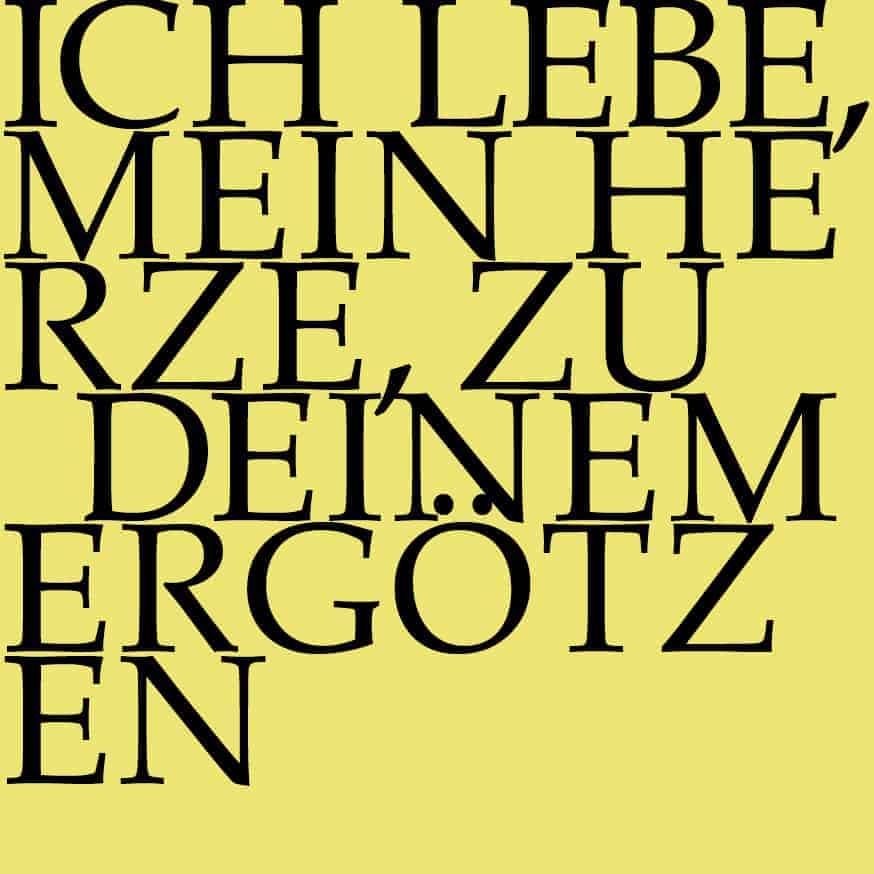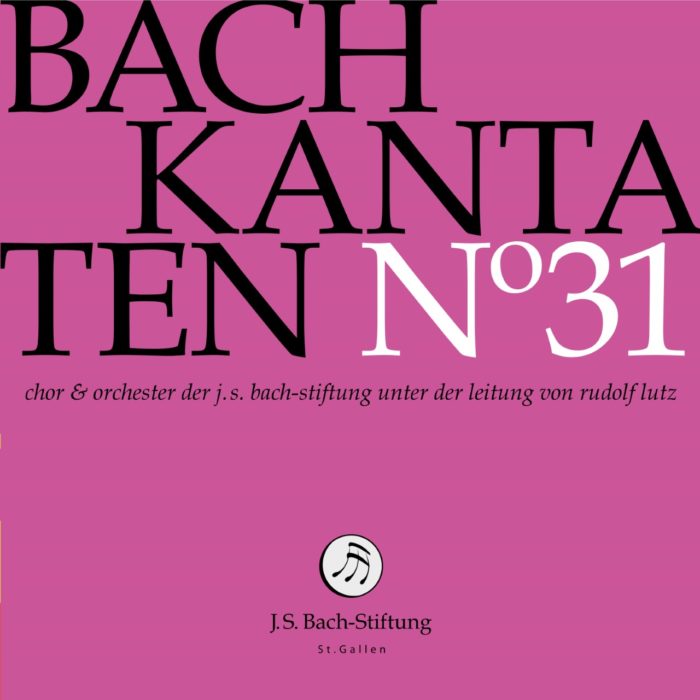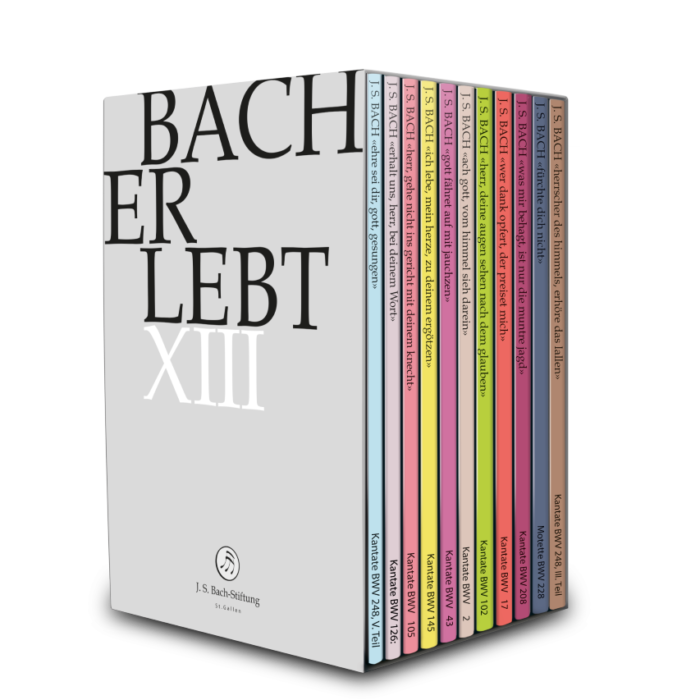Ich lebe, mein Herze, zu deinem Ergötzen
BWV 145 // For the Third day of Easter
(I live now, my spirit, to thy purest pleasure) for soprano, tenor and bass, oboe d’amore I+II, transverse flute, trumpets, strings and basso continuo

Would you like to enjoy our videos ad-free? Subscribe to YouTube Premium now...
Workshop
Reflective lecture
Bonus material
Orchestra
Conductor & harpsichord
Rudolf Lutz
Violin
Renate Steinmann, Olivia Schenkel, Claire Foltzer, Elisabeth Kohler, Marita Seeger, Salome Zimmermann
Violoncello
Martin Zeller
Violone
Markus Bernhard
Trumpet
Patrick Henrichs
Transverse flute
Tomoko Mukoyama
Oboe d’amore
Andreas Helm, Philipp Wagner
Bassoon
Susann Landert
Organ
Nicola Cumer
Musical director & conductor
Rudolf Lutz
Workshop
Participants
Rudolf Lutz, Pfr. Niklaus Peter
Reflective lecture
Speaker
Sr. Manuela Schreiner
Recording & editing
Recording date
26/04/2019
Recording location
ev. Kirche St. Mangen // St. Gallen
Sound engineer
Stefan Ritzenthaler, Nikolaus Matthes
Director
Meinrad Keel
Production manager
Johannes Widmer
Production
GALLUS MEDIA AG, Switzerland
Composer of sinfonia
Rudolf Lutz
Producer
J.S. Bach Foundation of St. Gallen, Switzerland
Librettist
First performance
19 April 1729, Leipzig
Text
Christian Friedrich Henrici (Picander), Leipzig, 1728/32
- Movement a (added later for a performance on Easter Day): Caspar Neumann (Breslau, around 1700)
- Movement b (added later from TWV 1:1350 for a performance on Easter Day); Romans 10:9
- Movement 5: Nikolaus Herman (1560)
In-depth analysis
The historical sources passed down as well as the stylistic features of cantata BWV 145 render it one of the most puzzling compositions included in the performance practice of Bach’s oeuvre: unresolved issues about the work’s authorship and whether it is even complete abound. The two editions of the libretto printed in 1728/29 by Picander, Bach’s “house poet” in Leipzig, certainly indicate a proximity to Bach’s work. Nevertheless, the extant manuscript stems from the 19th century and is thought to be associated with Carl Friedrich Zelter’s choir academy in Berlin; this version prefaces Picander’s five-movement libretto with two additional movements that can be traced to Carl Philipp Emanuel Bach (chorale movement “Auf, mein Herz”) and Georg Philipp Telemann (chorus movement “So du mit deinem Munde”, from a cantata of the same name), thus providing evidence of an arrangement from the late 18th century. Furthermore, obvious disparities in musical style even among the five movements set to the Picander text cast doubt on Bach’s sole authorship, making it conceivable that the Thomascantor prepared the work for performance together with a student – for example the young Carl Philipp Emanuel Bach. Indeed, this is no far-fetched assumption: the limited number of surviving settings of what is known as the “Picander cycle” by Bach senior has led Peter Wollny and other Bach scholars to posit that the work was distributed among various composers.
In its traditional form, the cantata begins with the chorale setting “Auf, mein Herz, des Herren Tag” (Rise, my heart, the Lord’s own day). Although the setting was included by Carl Philipp Emanuel Bach in a publication of his father’s four-part chorales, the work has since been proven to be written by the son, which corresponds to the music’s somewhat plainer style. The Telemann chorus “So du mit deinem Munde bekennest Jesum” (If thou with thine own mouth dost acknowledge Jesus) originates from an Easter cantata of the same name (TWV 1:1350) composed in 1723. Set in two parts, it opens with a charming sopranoalto duet followed by a vivace choral fugue, which, thanks to its obbligato trumpet part (and despite some breathless melodic writing and static cadences) generates considerable musical energy.
The actual Picander setting opens with the duet “Ich lebe, mein Herze” (I live now, my spirit) featuring a violin obbligato part. Considering the setting’s somewhat eager manner, it is not unreasonable to think it a parody of a secular work from Bach’s Cöthen period or perhaps the work – at least partially – of a younger composer emulating Bach’s style. The following tenor recitative “Nun fordre Moses, wie du willt” (Now order, Moses, as thou wilt) bids adieu with a decisive gesture to the “dräuende Gesetz” (threatening law) of the Old Covenant; the moving adagio passage “Mein Herz, das merke dir” (My heart, remember this) is particularly typical of Bach’s recitative style. By contrast, the following bass aria – the only setting of the five Picander movements to employ the score’s full instrumentation, including trumpet, transverse flute and two oboes d’amore – leaves an oddly inconsistent impression. While some passages (such as the harmonically interesting conclusion to the introductory ritornello) are convincingly Bachian in style, the simple opening unison figure and occasionally hesitant progressions seem somewhat incomplete – an impression that does not, however, impede the effect of the lecturing bass part. In the following recitative, the soprano returns to proclaim how solace and the strength to renounce earthly pleasures is found in the life and resurrection of Jesus. Finally, the closing chorale, which with its archaic, Early Reformation melody stands in clear contrast to the galant style of the arias and the Telemann chorus, seems to only reinforce the idiosyncratic nature of this pasticcio cantata.
It is clear that the later additions to the Picander version were made with an eye to improving the work’s structural balance and, in particular, to make better use of its full orchestration. Inspired by the fact that it would have been entirely atypical of Bach to open a cantata with a four-part chorale setting, but that Picander’s libretto nevertheless in no way precludes the work from being preceded by a sinfonia (as for instance in cantata BWV 42), Rudolf Lutz, as part of his musical analysis and preparation for the performance, composed a short three-section instrumental movement. Written in the style of an overture and featuring various baroque topoi, this new composition introduces the probable torso of the work into a coherent form – an alternative arrangement that we also offer in this recording for discussion.
Libretto
Erste Aufführung
a) Choral (BWV 145/1)
Auf, mein Herz, des Herren Tag
hat die Nacht der Furcht vertrieben:
Christus, der im Grabe lag,
ist im Tode nicht geblieben.
Nunmehr bin ich recht getröst,
Jesus hat die Welt erlöst.
b) Chor (Georg Philipp Telemann, aus der Kantate TWV 1:1350)
«So du mit deinem Munde bekennest Jesum,
dass er der Herr sei, und gläubest in
deinem Herzen, dass ihn Gott von den Toten
auferwecket hat, so wirst du selig.»
Es folgen: Nummern 1 – 5
Zweite Aufführung
a) Sinfonia zu BWV 145 (Rudolf Lutz)
Es folgen: Nummern 1 – 5
1. Arie — Duett
(Jesus: Tenor, Seele: Sopran)
Jesus
Ich lebe, mein Herze, zu deinem Ergötzen,
mein Leben erhebet dein Leben empor.
Seele
Du lebest, mein Jesu, zu meinem Ergötzen,
dein Leben erhebet mein Leben empor.
Die klagende Handschrift ist völlig zerrißen,
der Friede verschaffet ein ruhig Gewißen
und öffnet den Sündern das himmlische Tor.
2. Rezitativ — Tenor
Nun fordre, Moses, wie du willt,
das dräuende Gesetz zu üben,
ich habe meine Quittung hier
mit Jesu Blut und Wunden unterschrieben.
Dieselbe gilt,
ich bin erlöst, ich bin befreit
und lebe nun mit Gott in Fried und Einigkeit,
der Kläger wird an mir zuschanden,
denn Gott ist auferstanden.
Mein Herz, das merke dir!
3. Arie — Bass
Merke, mein Herze, beständig nur dies,
wenn du alles sonst vergißt,
daß dein Heiland lebend ist;
merke, mein Herze, beständig nur dies.
Lasse dieses deinem Gläuben
einen Grund und Feste bleiben,
auf solchem besteht er gewiß.
Merke, meine Herze, merke nur dies!
4. Rezitativ — Sopran
Mein Jesus lebt,
das soll mir niemand nehmen,
drum sterb ich sonder Grämen.
Ich bin gewiß
und habe das Vertrauen,
daß mich des Grabes Finsternis
zur Himmelsherrlichkeit erhebt;
mein Jesus lebt,
ich habe nun genug,
mein Herz und Sinn
will heute noch zum Himmel hin,
selbst den Erlöser anzuschauen.
5. Choral
Drum wir auch billig fröhlich sein,
singen das Halleluja fein
und loben dich, Herr Jesu Christ;
zu Trost du uns erstanden bist.
Halleluja!
Manuela Schreiner
Divine music to grasp God
Let us listen together for a little moment to the uplifting silence….
Do you feel that what we hear grows with the silence within us?
I feel as if it is swelling within me.
Lingering in this listening, I sense a movement. Perhaps it is the sounds forming in my heart?
No, I think it is rather an intimate dance – it is the uplifted soul perceiving itself in its true vocation and dancing for the joy of this truth!
Can you feel it too?
Look, Jesus has taken hold of me deeply….
I believe that is why you have called me here today to this Easter Octave.
That is why I am standing here – as a religious – and am invited to give witness through this dress alone!
We are all gripped by what we have just heard. We are “HE-grabbed”, that means for me, it is God, it is HE – of whom John (21, 7; Then the disciple whom Jesus loved said to Peter, “It is the Lord!” When Simon Peter heard that it was the Lord, he girded on his outer garment, because he was naked, and jumped into the lake.) while fishing after Jesus’ resurrection, says to Peter, “It is the Lord!” Because of this realisation Peter puts on the outer garment and jumps into the lake full of overwhelming feeling and longing to get to the Lord – to the Beloved.
We, too, feel this knowing of Him, this being carried away, because we perceive Him who takes hold of us through divine music, who touches us and draws us into His reality.
Yes – it is indeed the music, it is the sung words that lift us up, that show us a reality of which we have suspected (hoped?) since childhood that it exists.
Why do we suspect it? Where does this longing come from … this little seed that touches our hearts again and again, that burns like a warm ember in us and is kindled by such witness-clear sounds?
Is it the longing for peace? For tidiness or better for purity of heart? …
Yes – it is hope that makes us sense this divine reality, and even more so, know it! It is the uplifting unfounded inner joy that seems to make HIM perceptible … sometimes even visible – above all in the shining eyes of happy children … in the shining eyes of those who hear or sing such music.
Justified Paul speaks in his Letter to the Hebrews (11, 1): “But faith is standing firm in what is hoped for. To be CONVINCED of things not seen…”
And already we perceive ourselves in our powerless smallness…, in our inability to know God….
And it is precisely in this smallness, in this inability, that God places the mighty resurrection of His Son! For it is HE who speaks from the words of the tenor:
“I live, my heart, for thy delight!”
Delight (!) – a word that is no longer familiar to us, that sounds strange to us. And yet it is an irreplaceable word, for Jesus speaks here to the soul: “I want to sink my desire for the living, for eternal life into your soul!”
Yes, it is my desire to take hold of you man, to draw you out of all that is dead and unhealed. It is my joy to immerse your heart in the same life-creating joy that called me out of death into life.
Look, it is your calling and mine, at least as Christians, to live out of this beatific promise, to be redeemed out of the promise. And this joyful power has an atomic effect!
The so-called “kleine Boschof”, Klaus Hemmerle, who was appointed Bishop of Aachen in 1975, coined the beautiful term “Osteraugen”. When we look at the world and our creation in the joy of a liberated and redeemed human being, then we give this world a new, a redeemed face, despite darkness and adversity, despite hatred and destruction. A new radiant reality … a glow of the very purpose to which we are called!
When we look at something with joy, it becomes alive, even the colours of a flower shine more freshly and happily when I look at it with joy. A happy look, a good word tells creation of its purpose, for not for nothing does the story of creation say at the end of each day of creation (Gen. 1, 10): “God saw that it was good!”
How can we feel ourselves as HE-redeemed, as human beings from whom the shackles of slavery to so many original sins have been removed? Because Jesus went the way of the cross FOR US, because HE bore all our burdens, everything negative, our sins … to set us free to live, to set us free for the infinite eternal love of the Father.
Through his cross HE took everything to give us a direct way, a new direct communication with the Father. We only have to believe, nothing greater and nothing smaller – only BELIEVE!
What human being can do that, that he carries something for others? Perhaps we manage it in small ways, perhaps when a beloved daughter, a beloved son suffers, we would gladly take this “for” upon ourselves. But we hardly manage it, or only a few graced ones. And precisely because this “FOR” is so difficult for us, God places Himself in this task. HE wants to be completely like us, although HE is so much greater and more exalted than we, His creatures.
When I look at my own life until today, I know exactly the days, the gloomy hours, when Jesus spoke this “for you” for me. HE did it so that I could come closer to HIM, because it was precisely through the heaviness of my life that HE came close to me, that I understood a little more of my own calling.
I keep seeing the image of a child who stumbles and falls while jumping around. And how the mother rushes to him, takes him in her arms, comforts him, perhaps heals the first pain with a little “Speuz”. That is exactly how God acts! He rushes to us who have fallen and are stuck with our soul on the ground (Ps 119:25). He hurries, lifts us up, comforts us in his arms and dabs our aching wounds.
What tenderness between Creator and creature … what longing do I encounter in my soul?
Then I want to join in and sing:
“I am certain and have confidence that the darkness of the grave lifts me up to the glory of heaven; my Jesus lives … my heart and mind still want to go to heaven today.”
This longing that we hear there can only be spoken by a soul that has encountered the tenderness and love of God the Father by falling.
And this bestowing love of the Father in the Son lifts us powerless and small human beings into a great kingship. The death and resurrection of Jesus raises us to the dignity of children of God. To nothing less are we called!!!
Let us join once again in this great love song between the human soul and the Risen One, so miraculously given to us today by such gifted artists. From their music speaks the triumphant joy of heaven, from the songs the joy of kingship … to which we are raised.
This text has been translated with DeepL (www.deepl.com).





